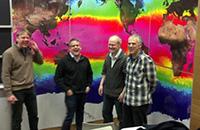"A picture's worth a thousand words" is the first thing Chris Hill, principal research engineer at MIT, says to describe the ceiling-to-floor map of the world ocean and continents that covers the walls outside his office in MIT's Department of Earth, Atmospheric, and Planetary Sciences (EAPS). In fact, this colorful visual explains far more than a thousand words can communicate. The picture is a detailed representation of ocean surface temperature at a particular time. It comes from the output of a computer model of the ocean that, with more than 10 billion grid cells, forms the highest-ever resolution run of a fully global ocean model, Hill says.
The map signifies a milestone application of the MIT General Circulation Model (MITgcm), a very widely used ocean modeling tool. Development of the MITgcm began at MIT 20 years ago this year. Ground zero for MITgcm development throughout that time has always been a handful of offices on the 14th and 15th floors of Building 54, but over the years the modeling work has grown to include a distributed diaspora of contributors around the globe. In addition to laying the foundation for these latest experiments, the collective efforts of this distributed team have produced a tool that has been deployed in well over 1,000 scientific publications over the last two decades, occupying 100 pages of Google Scholar references.
MITgcm creates a virtual 3-D global ocean complete with sea ice. To understand how this works, imagine stretching a fine-mesh grid over the entire globe, dividing it into boxes. At each grid point, a calculator is continually solving sets of equations based on physical laws governing Earth's fluid motion. Into these equations, researchers input measurements from real-world observations of temperature, salinity, and velocity. The smaller the boxes, the higher the model's resolution and the better it will capture small-scale fluid features.
The most recent high-resolution experiments zoom down to nearly one-kilometer boxes over the entire planet and perform math on billions of grid points, over and over, to advance the virtual ocean state. At close to one kilometer resolution, the model captures some key fluid dynamical phenomena that are central to the large-scale behavior of the ocean. Resolving these processes in a global model is a breakthrough that will help advance basic understanding of the nature of ocean circulation on Earth.
What is beginning to emerge is in some ways an oceanographic analog of a giant telescope. The modeled ocean lets researchers examine how ocean dynamics behave both at the planetary scale and at fine scales of close to one kilometer simultaneously. By analyzing the model solutions, researchers can test hypotheses about which fluid processes control ocean behavior, and observe when and where different phenomena matter. In the place of the telescope lens, there are instead massive computing facilities.
This MITgcm experiment is currently running its virtual world on 5,000 computers — that's 50,000 central processing units — in the NASA Advanced Supercomputing Facility at Ames Research Center in California's Silicon Valley. Analysis and diagnostic calculations are being carried out at various large computing facilities nationwide, including at the multi-university Massachusetts Green High Performance Computing Center, recently built to support future growth in computationally enabled research activities at MIT.
Hill recently printed out this vibrant image of the model ocean's surface temperature field at one instant in time to show people what he and his colleagues have been working toward for 20 years. "It's difficult to just look at a computer screen and see all the large and small-scale patterns represented by the model," Hill says. "This gives the visual impact." Indeed, the curling filaments visible on the map show just how well the model can resolve the small-scale currents, such as eddies, that transport heat, carbon, and biological properties within global circulation systems.
Seeing is believing
The modeling endeavor was unveiled at MIT in a January 22-24 meeting of the Estimating the Circulation and Climate of the Ocean (ECCO) consortium, a joint venture led by MIT, NASA's Jet Propulsion Laboratory, and Scripps Oceanographic Institution that combines observations and the MITgcm to obtain a more realistic understanding of ocean circulation, how it evolves over time, and its impact on global climate.
This MITgcm experiment is a milestone in the ECCO ocean modeling world because researchers can see at last what a virtual ocean looks like at higher resolutions, and they now have a new tool to evaluate the accuracy of their modeling practices and assumptions. For example, while lower-resolution models that run at tens or even hundreds of kilometers cannot resolve ubiquitous turbulent ocean eddies, they do account for the influence of eddies with classical equations. Zooming in closer will reveal whether these well-worn equations actually capture the eddy dynamics in the way people think they do.
"We just have to channel Osborne Reynolds," Hill said in his discussion of the model’s potential. His remark, which drew a laugh from the ECCO audience, referred to the Victorian-era fluid dynamicist who studied the swirly instability patterns that result when jets of fluid are sent into other fluids. Reynolds wanted to represent these small-scale structures in mathematical equations that describe bulk fluid flow. Fast-forward to 2014, and ECCO modelers are asking similar questions about the entire ocean, using virtual worlds instead of lab experiments to examine how their understanding of the tiny fluxes of temperature and momentum from small-scale circulations relates to what they see on the large scale.
This article is Part I of a longer story. Part II looks at an example of how high-resolution MITgcm simulations are informing our understanding of marine ecology through work by other researchers in EAPS involved in the MIT Darwin Project. You can read both parts of this story at Oceans at MIT.
Link to article:



